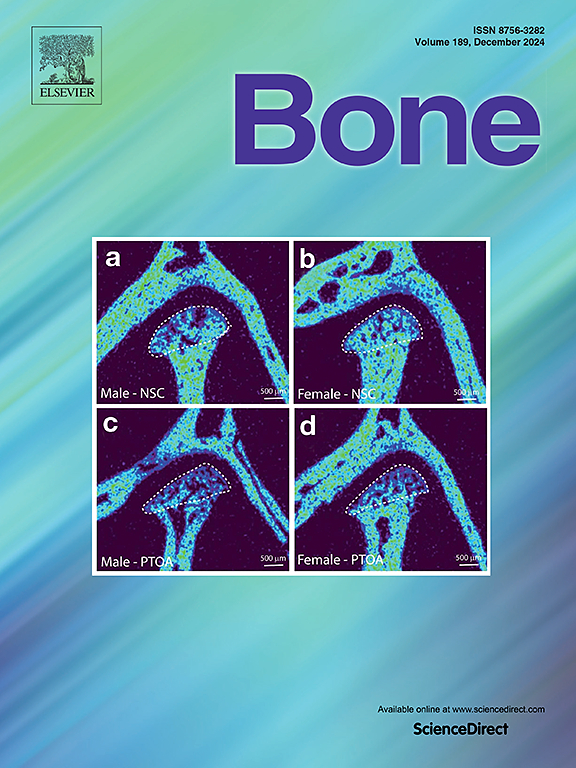Relation of lateral lumbar spine DXA to age-related bone loss, aortic calcification, scoliosis and vertebral degeneration: Analysis of over 10,000 patients
IF 3.6
2区 医学
Q2 ENDOCRINOLOGY & METABOLISM
引用次数: 0
Abstract
Dual-energy X-ray absorptiometry (DXA) is a valuable tool for measuring bone mineral density (BMD). Conventional skeletal projection images for BMD assessment include the hip and the posterior-anterior (PA) lumbar spine DXA scans. However, the PA view suffers from the pileup of anatomical structures which are not present in the lateral view. This study aimed to evaluate the significance of lateral projection in measuring BMD.
We acquired a dataset covering over 10,000 patients with the lateral projection included in the routine clinical DXA examination together with PA lumbar spine and femur projections. Age-related BMD decrease was more pronounced in the lateral lumbar spine and femur than in the PA lumbar spine. To elaborate on this difference, we estimated aortic calcification score from lateral spine DXA images and detected degeneration and scoliosis from PA lumbar spine images using neural networks. Multivariate linear regression analysis suggested that aortic calcification increased BMD in PA spine, but in lateral spine and femur, the expected decline in BMD was observed. The spinal degeneration was related to higher BMD in all sites, with the largest effect on PA spine BMD. Scoliosis increased BMD on lateral spine but was associated with decreased BMD in PA spine and at femur.
Lateral lumbar spine DXA helped to reveal sources for the artificially elevated BMD and provided better insight into age-related decrease in vertebral bone mineral density than the PA scan. Lateral projection should therefore be considered more in clinical practice, as it enhances the reliability of lumbar spine BMD measurement.

侧位腰椎DXA与年龄相关性骨质流失、主动脉钙化、脊柱侧凸和椎体退变的关系:1万多例患者的分析
双能x线骨密度仪(DXA)是测量骨密度(BMD)的一种有价值的工具。用于BMD评估的常规骨骼投影图像包括髋关节和腰椎后前位DXA扫描。然而,正侧位面有堆积的解剖结构,这在侧面面是不存在的。本研究旨在评价侧位投影测量骨密度的意义。我们获得了一个数据集,涵盖了10,000多名患者,其中包括常规临床DXA检查中的侧位投影以及PA腰椎和股骨投影。与年龄相关的骨密度下降在侧腰椎和股骨中比在正侧腰椎中更为明显。为了详细说明这一差异,我们利用神经网络估算了侧位脊柱DXA图像的主动脉钙化评分,并检测了PA腰椎图像中的退变和脊柱侧凸。多元线性回归分析显示主动脉钙化增加了正侧脊柱的骨密度,但在侧侧脊柱和股骨中,骨密度出现了预期的下降。脊柱退变与所有部位的高骨密度有关,对PA脊柱骨密度的影响最大。脊柱侧凸增加了侧脊柱的骨密度,但与正侧脊柱和股骨的骨密度下降有关。腰椎侧位DXA有助于揭示人为升高骨密度的来源,并比PA扫描更好地了解与年龄相关的椎体骨密度下降。因此,在临床实践中应更多地考虑侧位投影,因为它提高了腰椎骨密度测量的可靠性。
本文章由计算机程序翻译,如有差异,请以英文原文为准。
求助全文
约1分钟内获得全文
求助全文
来源期刊

Bone
医学-内分泌学与代谢
CiteScore
8.90
自引率
4.90%
发文量
264
审稿时长
30 days
期刊介绍:
BONE is an interdisciplinary forum for the rapid publication of original articles and reviews on basic, translational, and clinical aspects of bone and mineral metabolism. The Journal also encourages submissions related to interactions of bone with other organ systems, including cartilage, endocrine, muscle, fat, neural, vascular, gastrointestinal, hematopoietic, and immune systems. Particular attention is placed on the application of experimental studies to clinical practice.
 求助内容:
求助内容: 应助结果提醒方式:
应助结果提醒方式:


